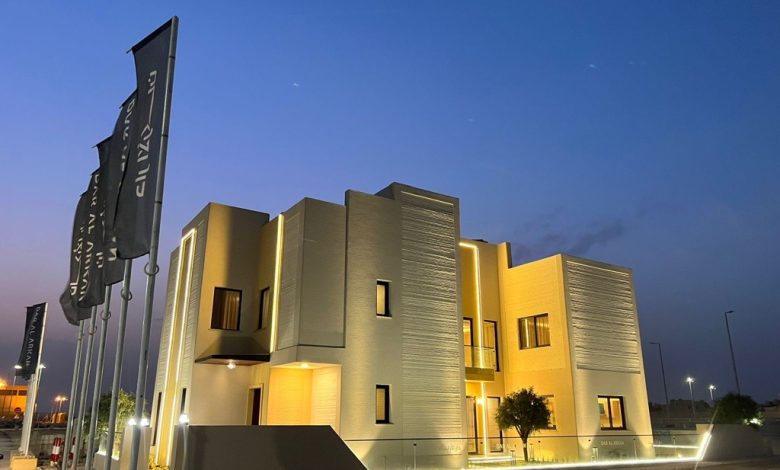While 3D printing technology is still a relatively new concept in construction, it has already proven effective at creating quality structures with less manpower and fewer wasted materials. Construction 3D printing (C3DP) usually involves a machine with a robotic arm extruding concrete while following a pre-programmed path to deposit layers until the structure is complete. C3DP has been used to build innovative structures throughout Europe, North America, and Asia.
However, Middle East countries, specifically the United Arab Emirates (UAE) and Saudi Arabia, are at the forefront of C3DP. In Saudi Arabia, Dar Al Arkan, a leading mixed-use real estate developer, recently constructed the world’s tallest 3D printed building: a 9.9-meter, three-story villa with 345 square meters of floor space.
Below is a closer look at this innovative structure and the state of C3DP in the construction industry.
Building Specifications and Construction Details
The 9.9-meter villa, located northwest of the Saudi capital in Shams Al Riyadh, has 130 square meters of space on its first floor, including multiple living areas and a spacious hall. There are three bedrooms, including a master bedroom, and a living room and balcony on the 140-square-meter second floor. The third floor, a roof annex, has a maid’s room, laundry room, and multipurpose hall.
As the tallest 3D printed building printed on-site, Dar Al Arkan constructed it during August and September 2022 in partnership with 3DCP leader COBOD International in a desert area where temperatures regularly exceeded 40 degrees Celsius. Construction was completed without the use of a tent in just 26 days while adhering to all applicable building rules and safety regulations.
The use of 3D printing provided the developers with greater design flexibility and enhanced cost efficiency. The villa also features a range of sustainable and smart features, including apps that control the lighting and air conditioning as well as nine rooftop solar panels. The building is also 40 percent more heat-resistant than non-3D-printed structures due to the use of heat-reflecting nano-technology in painting the exterior walls.
Collaboration with COBOD
A global leader in C3DP, COBOD International has sold more than 50 printers to construction companies worldwide and is working toward automating at least 50 percent of construction processes at building sites with its innovative technology. The company was an early leader in C3DP, creating the first 3D-printed building in Europe in 2017. It has since produced the first two- and three-story 3D-printed buildings in North America, Europe, and India. General Electric, PERI, CEMEX, and Holcim are the major shareholders in the privately-owned company.
Part of Vision 2030
Saudi Arabia’s Vision 2030 is a comprehensive roadmap toward transforming its society and economy and includes mega projects such as NEOM and Qiddiya. Sustainability is a key component of Vision 2030 as the Kingdom hopes to achieve net zero emissions by 2060, and the use of C3DP in building projects will help Saudi Arabia in progressing toward that target. The aforementioned villa is the first of several that Dar Al Arkan intends to build in a 12-million-square-meter plot of land. These homes are constructed in a more environmentally friendly manner and include various energy conservation features, including additional insulation layers.
Commenting on the villa, a representative from the Saudi Ministry of Housing said that the Kingdom is developing its construction sector with a focus on building technology. Ultimately, the goal is to allow 70 percent of the Saudi population to own their own homes by 2030.
Other Examples of 3D Printed Buildings
PERI developed the first-ever three-story 3D printed building in Germany in 2021. Since then, developers have used the technology to create flexible and innovative designs and to address the global housing crisis. With support from private donors, the development company New Story built 50 3D-printed homes in Mexico’s southern region, where many families live in makeshift shelters. In Asia, WinSun Decoration Design Engineering Co., a Chinese developer, has built a five-story apartment block using the technology. WinSun also attracted press for producing 10 3D-printed homes in less than 24 hours.
Other recent examples of innovation in C3DP include the world’s first 3D printed office building and the Municipal Building in Dubai. Striving to cut building costs and expedite projects, the Dubai government is aiming to use C3DP for 25 percent of all new builds by 2030.
Architectural Concerns
Detractors of C3DP suggest the building process is either a fad or a publicity stunt as part of global efforts to lower emissions. Journalist Jack Balderrama Morley, for example, in an opinion piece for Architizer, suggests it’s unreasonable to expect 3D printing to replace the “dozens of techniques” used in traditional builds. There are also issues concerning regulatory challenges, quality control, and upfront investment costs. With some exceptions, particularly in the UAE and Saudi Arabia, there’s a lack of government oversight in C3DP, and creating new building codes to reflect the technology could take time.

